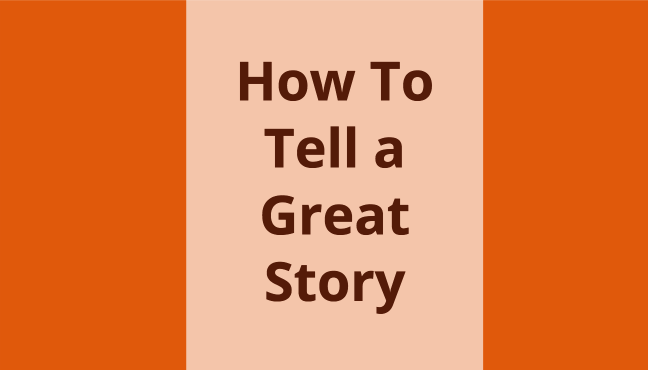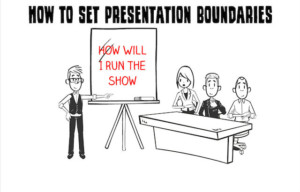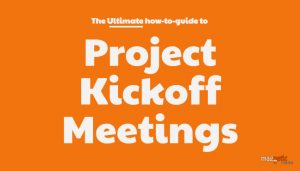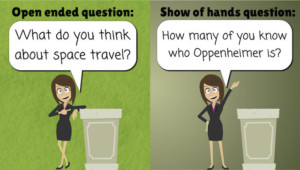You are born a storyteller? Someone that knows how to tell a great story.
Like most kids, you probably played with rocks, sticks, toys and created grand narratives before you even could talk properly.
You tell stories all the time, and you probably don’t even notice it. You share stories with management, customers, colleagues and direct reports in various situations. Start paying attention, and I guarantee you will be blown away with how many stories you share every single day.
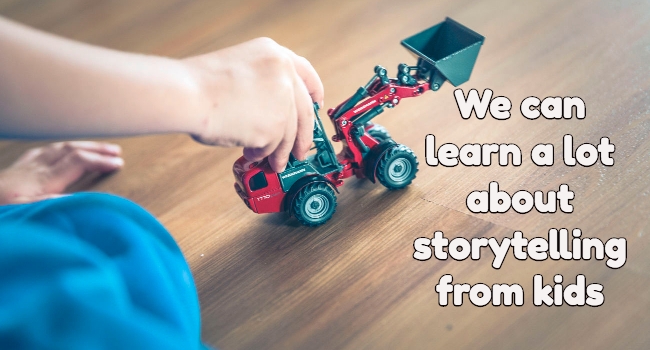
This article is not about getting you to tell stories because you do already – it’s about getting you to tell your stories better; to help you tell a great story every time.
If you want hands-on an interactive training on storytelling for business, check out the Magnetic Storytelling Boot Camp.
Elements To Help you Tell A Good Story:
In business, you tell stories to engage, persuade, and help your audience remember your message.
When I was an engineer in my previous life, I was always biased towards numbers to make my point. I used to give charts, stats, and bury people with numbers. I thought I was doing well until my mentor at the time (the director of engineering) told me that it’s not important how much you share with the audience, what matters is how much they remember. That’s when I started my journey into learning everything I can about storytelling to balance my message and make it memorable.
I’ve been studying storytelling for over ten years now and how it to apply it to a business setting. Below are some of the things I’ve learned that will help you tell a great story!
Logical narrative
Your story has to make logical sense. Have you ever heard a story that was all over the place? You probably did not enjoy it.
To have a clear narrative focus on one incident, one person, or one event. Don’t try to tell multiple stories at once, be systematic and strategic with the sequence of your story so that your audience can follow along.
A good narrative usually goes from a setup up to climax then ends with a resolution.
Simple example:
- A boy bikes to school every day
- one day his bike broke
- so he took the bus for the first time in his life.
Notice that is a simple plot, but it makes sense. Your story has to make sense to make an impact.
Good stories have emotions:
Every great story must have emotions embedded into it. If you just focus on a logical narrative, then your story will be boring. You need to breathe life into your presentation by injection emotions.
That’s easy to do. All you have to do is run two parallel tracks. One track will be the sequence of events; the other track will be the emotions of the story.
So if we use the simple logical narrative from above: “A boy bikes to school every day, one day his bike broke, so he took the bus for the first time in his life.:
Here is how it will look when we add emotions to it:
All the emotions are in brackets for emphasis [….]
- A boy bikes to school every day
- [He loves it, it’s the only time in the day he feels like a grown up],
- one day his bike broke
- [it almost broke his heart, like his independence was stolen from him],
- so he took the bus for the first time in his life
- [he learned that there are many ways to be independent].
Notice how the emotional track makes the story more interesting and more emotionally engaging? I typically start with the logical track just to make sure the story makes sense; then I give it life by adding the emotional track.
Here is a visual representation of the parallel tracks:
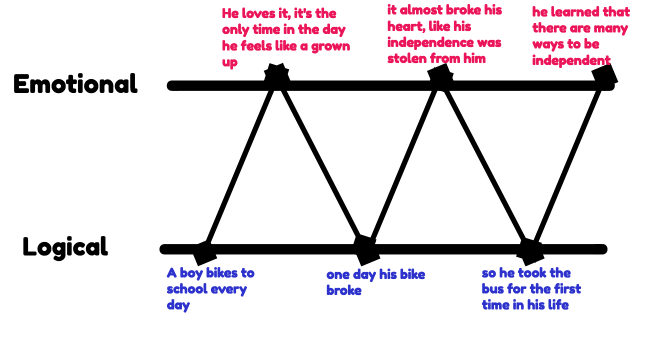
Good Stories are Presented Dynamically
You can always tell a great storyteller from across a room. She will act out the story with her hands and vocal variety as if the story is happening right now. The dynamic delivery is what captivates an audience.
You don’t have to envy the dynamic storyteller – all you have to do is do the same.
So how do you tell a great story dynamically?
The easiest way is to relive the story and say it in the present tense:
Instead of saying: “I did a self-guided tour of Paris last week.”
Say: “So I am walking downtown Paris with a smile on my face. I can’t understand anything the people are saying, but I am living the dream…”
In addition to telling the story in present tense, act it out. As you are saying that you are walking, act it out.
I am not saying go overboard here and do a mini play on stage. Just do a little bit so that your hands and body are moving a bit as if you are reliving the story.
We have a whole segment on this in the Magnetic Storytelling Boot Camp if you want to practice and get feedback on doing this the right way.
Make your story great with a frame.
The difference between telling a good story and telling a great story is the framing. The framing is the meaning or the lesson attached to the story.
Have you ever heard a story and thought “wow this is great!” But you did not know what it means? In those cases, the speaker must have left the frame of the story out.
A frame is a lesson or the moral of the story that comes at the end. Typically you would use one of the following stem sentences to telegraph the frame:
- This means…
- This tells us…
- What I get from the story is…
- The moral of the story is …
For example, if we use the simple story above here is what the frame will look like:
- A boy bikes to school every day
- [He loves it, it’s the only time in the day he feels like a grown up]
- one day his bike broke
- [it almost broke his heart, like his independence was stolen from him]
- so he took the bus for the first time in his life
- [he learned that there are many ways to be independent]
- Frame: The moral of the story is that kids will get more out of life if their routine changes.
You can have any Frame you want instead of the one I picked. The point is that a frame will make a good story great.
Conclusion: How to Tell a Great Story
You are born a storyteller. The idea here to transform your regular stories into great stories that help you engage, persuade and move your audiences. Whether you want to tell a good story or a great one, you need to have four elements every time you tell a story: Logical narrative, emotions, dynamic delivery, and framing.
